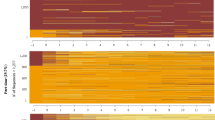Abstract
Utilizing unique data generated from the National Longitudinal Surveys of Young Women, this paper examines the labor force participation of young mothers in the months immediately preceding and following the birth of the first child. Labor supply behavior at this point in the life cycle is described in greater detail than has hitherto been available. In addition, we analyze the independent effect of several factors of interest on the probability that a young woman will be in the labor force during various intervals surrounding the first birth.
Similar content being viewed by others
References
Borus, Michael E., Frank L. Mott, and Gilbert Nestel 1978. Are Youth Counted? Columbus: Center for Human Resource Research, The Ohio State University.
Bowen, William G., and T. Aldrich Finegan. 1969. The Economics of Labor Force Participation. Princeton: Princeton University Press.
Center for Human Resource Research. 1977. The National Longitudinal Surveys Handbook. Columbus: Center for Human Resource Research, The Ohio State University.
Gronau, R. 1973. The Effect of Children on the Housewife’s Value of Time. Journal of Political Economy 81:S168-S199.
Heckman, J. 1974. Shadow Prices, Market Wages, and Labor Supply. Econometrica 42:679–694.
—, and R. J. Willis. 1977. A Beta-logistic Model for the Analysis of Sequential Labor Force Participation by Married Women. Journal of Political Economy 85:27–58.
Mincer, J., and S. Polachek. 1974. Family Investments in Human Capital: Earnings of Women. Journal of Political Economy 82:S76-S108.
Mott, Frank L., S. H. Sandell, D. Shapiro, P. K. Brito, T. J. Carr, R. C. Johnson, C. L. Jusenius, P. J. Koenig, and S. F. Moore. 1977. Years for Decision, Volume 4. Columbus: Center for Human Resource Research.
Sandell, S. H., and D. Shapiro. 1978. The Theory of Human Capital and the Earnings of Women: A Re-examination of the Evidence. Journal of Human Resources 13:103–117.
U.S. Bureau of the Census. 1973. Census of Population. Subject Reports. Final Report PC(2)-6A, Employment Status and Work Experience. Washington, D.C.: U.S. Government Printing Office.
Author information
Authors and Affiliations
Rights and permissions
About this article
Cite this article
Shapiro, D., Mott, F.L. Labor supply behavior of prospective and new mothers. Demography 16, 199–208 (1979). https://doi.org/10.2307/2061138
Issue Date:
DOI: https://doi.org/10.2307/2061138



